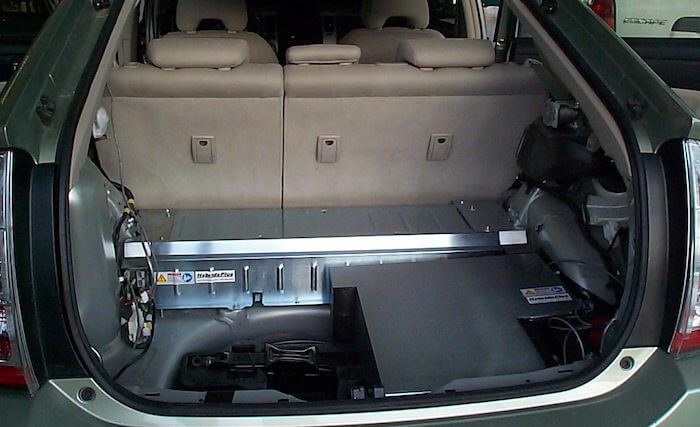
P0A7D Hybrid battery pack Low battery
Content
- P0A7D Hybrid battery pack Low battery
- OBD-II DTC Datasheet
- What does this mean?
- What is the severity of this DTC?
- What are some of the symptoms of the code?
- What are some of the common causes for the code?
- What are some steps to troubleshoot P0A7D?
- Related DTC discussions
- Need more help with the P0A7D code?
P0A7D Hybrid battery pack Low battery
OBD-II DTC Datasheet
Hybrid battery pack Low battery
What does this mean?
This is a generic Diagnostic Trouble Code (DTC) applicable to many OBD-II vehicles (1996 and newer). This may include, but is not limited to, vehicles from Toyota (Prius, Camry), Lexus, Fisker, Ford, Hyundai, GM, etc. Despite the general nature, the exact repair steps may vary depending on the year, make, model and transmission configuration.
If your hybrid vehicle (HV) has stored the P0A7D code, it means the powertrain control module (PCM) has detected an insufficient charge level as it relates to the high voltage battery. This code should only be stored in hybrid vehicles.
Typically, a high voltage (NiMH) battery consists of eight (1.2 V) cells in series. Twenty-eight of these cells make up the HV battery pack. The hybrid vehicle battery management system (HVBMS) is responsible for regulating and monitoring the high voltage battery. HVBMS interacts with PCM and other controllers as needed.
Cell resistance, battery voltage, and battery temperature are all factors that HVBMS (and other controllers) take into account when calculating battery health and desired state of charge. Most hybrid vehicles use an HVBMS system where each cell is equipped with an ammeter/temperature sensor. The HVBMS monitors data from each cell and compares individual voltage levels to determine if the battery is operating at the desired charge level. After the data is calculated, the corresponding controller reacts accordingly.
If the PCM detects a voltage level from the HVBMS that is insufficient for the conditions, a P0A7D code will be stored and a malfunction indicator lamp (MIL) may illuminate. In some cases, it will take multiple failure cycles to illuminate the MIL.
Typical Hybrid Battery: 
What is the severity of this DTC?
Stored code P0A7D and all other codes related to HVBMS should be considered severe and treated as such. If this code is stored, the hybrid powertrain may be disabled.
What are some of the symptoms of the code?
Symptoms of a P0A7D trouble code may include:
- Reduced fuel efficiency
- Decreased overall performance
- Other codes related to high voltage battery
- Disconnection of the electric motor installation
What are some of the common causes for the code?
Reasons for this code may include:
- Defective high voltage battery, cell or battery pack
- Defective generator, turbine or generator
- HVBMS sensor malfunction
- HV Battery Fans Not Working Properly
- Loose, broken or corroded busbar connectors or cables
What are some steps to troubleshoot P0A7D?
If battery charging system codes are also present, diagnose and repair them before attempting to diagnose P0A7D.
To accurately diagnose the P0A7D code, you will need a diagnostic scanner, digital volt / ohmmeter (DVOM), and a HV battery system diagnostic source.
Begin by visually inspecting the HV battery and all circuits. Look for signs of corrosion, damage, or open circuits. Remove corrosion and repair defective components if necessary.
Use the scanner to retrieve all stored codes and associated freeze frame data. After recording this information, clear the codes and test drive the vehicle. If possible, test drive the vehicle until the PCM enters readiness mode or the code is cleared.
If P0A7D is reset, use the scanner to monitor HV battery charge data and battery charge status. Obtain battery test procedures and specifications from your high voltage information source. Locating appropriate component layouts, wiring diagrams, connector faces, and connector pinouts will aid in accurate diagnostics.
If the battery is found to be defective: HV battery repair is possible but may not be reliable. The surest way to fix a failed HV battery pack is to replace it with a factory one, but this can be prohibitively expensive. In such a case, consider the correct HV battery pack to be used.
If the battery is within functional specifications, test the appropriate HVBMS (temperature and voltage) sensors following the manufacturer's specifications and testing procedures. This can be done using DVOM. Replace sensors that do not meet manufacturer's specifications.
If all sensors are working properly, use the DVOM to test the resistance of individual cells. Cells that show an unacceptable degree of resistance must have bus connectors and cables verified with a DVOM.
- Failed battery cells and batteries can be replaced, but a complete HV battery replacement is usually the most reliable solution.
- A stored P0A7D code does not automatically deactivate the HV battery charging system, but conditions that caused the code to be stored may disable it.
- If the HV in question has more than 100,000 miles on the odometer, suspect a defective HV battery.
- If the vehicle has traveled less than 100 miles, a loose or rusty connection is likely the cause of the problem.
Related DTC discussions
- There are currently no related topics in our forums. Post a new topic on the forum now.
Need more help with the P0A7D code?
If you still need help with DTC P0A7D, post a question in the comments below this article.
NOTE. This information is provided for informational purposes only. It is not intended to be used as a repair recommendation and we are not responsible for any action you take on any vehicle. All information on this site is protected by copyright.
